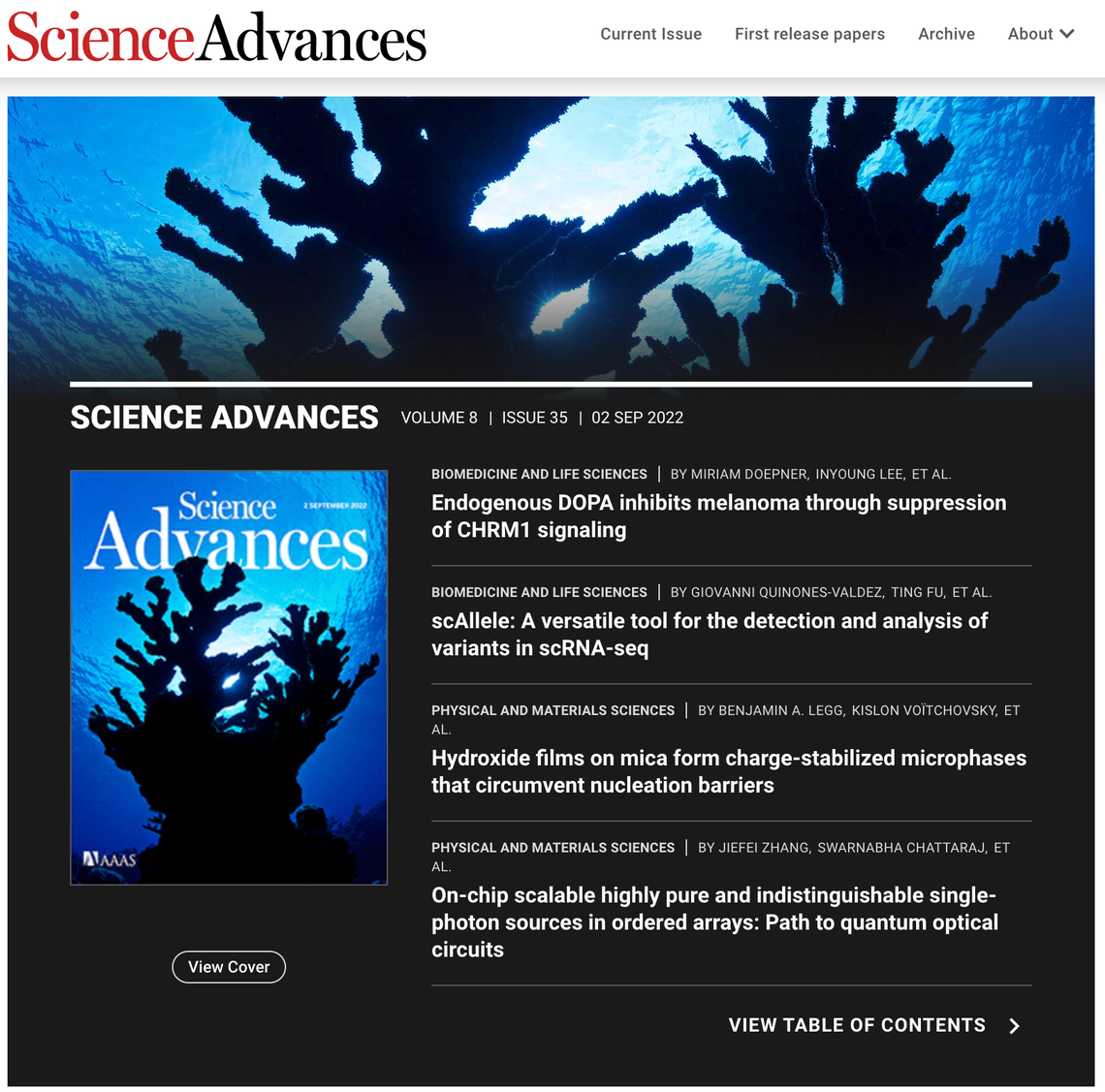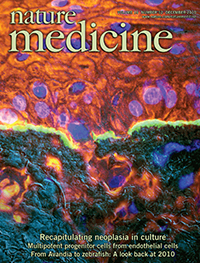Selected Publications from Ridky Lab Members
Targeting anti-apoptotic pathways eliminates senescent melanocytes and leads to nevi regression. Kohli J, Ge C, Fitsiou E, Doepner M, Brandenburg SM, Faller WJ, Ridky TW, Demaria M.
Nat Commun. 2022 Dec 23;13(1):7923. doi: 10.1038/s41467-022-35657-9. PMID: 36564381
Endogenous DOPA inhibits melanoma through suppression of CHRM1 signaling. Doepner M, Lee I, Natale CA, Brathwaite R, Venkat S, Kim SH, Wei Y, Vakoc CR, Capell BC, Katzenellenbogen JA, Katzenellenbogen BS, Feigin ME, Ridky TW. Sci Adv. 2022 Sep 2;8(35):eabn4007. doi: 10.1126/sciadv.abn4007. PMID: 36054350
ZIP9 is a Druggable Determinant of Sex Differences in Melanoma. Aguirre-Portolés C, Payne R, Trautz A, Foskett JK, Natale CA, Seykora JT, Ridky TW. Cancer Res. 2021 Oct 27:canres.0982.2021. doi: 10.1158/0008-5472.CAN-21-0982. PMID: 34706862
Pharmacologic Activation of the G Protein-Coupled Estrogen Receptor Inhibits Pancreatic Ductal Adenocarcinoma. Natale CA, Li J, Pitarresi JR, Norgard RJ, Dentchev T, Capell BC, Seykora JT, Stanger BZ, Ridky TW. Cell Mol Gastroenterol Hepatol. 2020;10(4):868-880.e1. doi: 10.1016/j.jcmgh.2020.04.016.
Exophilin-5 supports lysosome-mediated trafficking required for epidermal differentiation. Monteleon CL, Lee IY, Ridky TW. J Invest Dermatol. 2019 May 10. pii: S0022-202X(19)31553-2. doi: 10.1016/j.jid.2019.04.014.
Lysosomes support the degradation, signaling, and mitochondrial metabolism necessary for human epidermal differentiation. Monteleon CL, Agnihotri T, Dahal A, Liu M, Rebecca VW, Beatty GL, Amaravadi RK, Ridky TW. J Invest Dermatol. 2018 Mar 8. pii: S0022-202X(18)30216-1. doi: 10.1016/j.jid.2018.02.035. [Epub ahead of print] PMID: 29526763
Activation of G protein-coupled estrogen receptor signaling inhibits melanoma and improves response to immune checkpoint blockade. CA Natale J Li J Zhang A Dahal T Dentchev BZ Stanger TW Ridky (2018) eLife 7:e31770. https://doi.org/10.7554/eLife.31770
Taylor LA, O'Day C, Dentchev T, Hood K, Chu EY, Ridky TW, Seykora JT. p15 Expression Differentiates Nevus from Melanoma. Am J Pathol. 2016 Dec;186(12):3094-3099. doi: 10.1016/j.ajpath.2016.08.009. Epub 2016 Nov 14. PubMedPMID: 27855847; PubMed Central PMCID: PMC5225287.
Duperret EK, Natale CA, Monteleon C, Dahal A, Ridky TW. The integrin αv-TGFβ signaling axis is necessary for epidermal proliferation during cutaneous wound
healing. Cell Cycle. 2016 Aug 2;15(15):2077-86. doi:10.1080/15384101.2016.1199306. Epub 2016 Jun 13. PubMed PMID: 27295308; PubMedCentral PMCID: PMC4968969.
Natale CA, Duperret EK, Zhang J, Sadeghi R, Dahal A, O'Brien KT, Cookson R, Winkler JD, Ridky TW. Sex steroids regulate skin pigmentation through nonclassical membrane-bound receptors. Elife. 2016 Apr 26;5. pii: e15104. doi: 10.7554/eLife.15104. PubMed PMID: 27115344; PubMed Central PMCID: PMC4863824.
Cárdenas C, Müller M, McNeal A, Lovy A, Jaňa F, Bustos G, Urra F, Smith N, Molgó J, Diehl JA, Ridky TW, Foskett JK. Selective Vulnerability of Cancer Cells by Inhibition of Ca(2+) Transfer from Endoplasmic Reticulum to Mitochondria. Cell Rep. 2016 Apr 5;15(1):219-20. doi: 10.1016/j.celrep.2016.03.045. PubMed PMID: 27050774.
Capell BC, Drake AM, Zhu J, Shah PP, Dou Z, Dorsey J, Simola DF, Donahue G, Sammons M, Rai TS, Natale C, Ridky TW, Adams PD, Berger SL. MLL1 is essential for
the senescence-associated secretory phenotype. Genes Dev. 2016 Feb 1;30(3):321-36. doi: 10.1101/gad.271882.115. PubMed PMID: 26833731; PubMed Central PMCID: PMC4743061.
Duperret EK, Dahal A, Ridky TW. Focal-adhesion-independent integrin-αv regulation of FAK and c-Myc is necessary for 3D skin formation and tumor invasion. J Cell Sci. 2015 Nov 1;128(21):3997-4013. doi: 10.1242/jcs.175539. Epub 2015 Sep 10. PubMed PMID: 26359297; PubMed Central PMCID: PMC4647167.
McNeal AS, Liu K, Nakhate V, Natale CA, Duperret EK, Capell BC, Dentchev T, Berger SL, Herlyn M, Seykora JT, Ridky TW. CDKN2B Loss Promotes Progression from Benign Melanocytic Nevus to Melanoma. Cancer Discov. 2015 Oct;5(10):1072-85. doi: 10.1158/2159-8290.CD-15-0196. Epub 2015 Jul 16. PubMed PMID: 26183406; PubMed Central PMCID: PMC4592422.
Monteleon CL, McNeal A, Duperret EK, Oh SJ, Schapira E, Ridky TW. IQGAP1 and IQGAP3 Serve Individually Essential Roles in Normal Epidermal Homeostasis and Tumor Progression. J Invest Dermatol. 2015 Sep;135(9):2258-2265. doi: 10.1038/jid.2015.140. Epub 2015 Apr 7. PubMed PMID: 25848980; PubMed Central PMCID: PMC4537348.
Ridky TW, Cotsarelis G. Vismodegib resistance in basal cell carcinoma: not a smooth fit. Cancer Cell. 2015 Mar 9;27(3):315-6. doi: 10.1016/j.ccell.2015.02.009. PubMed PMID: 25759014.
Duperret EK, Ridky TW. Kindler syndrome in mice and men. Cancer Biol Ther. 2014 Sep;15(9):1113-6. doi: 10.4161/cbt.29482. Epub 2014 Jun 11. PubMed PMID: 24919121; PubMed Central PMCID: PMC4128853.
Duperret EK, Oh SJ, McNeal A, Prouty SM, Ridky TW. Activating FGFR3 mutations cause mild hyperplasia in human skin, but are insufficient to drive benign or malignant skin tumors. Cell Cycle. 2014;13(10):1551-9. doi: 10.4161/cc.28492. Epub 2014 Mar 12. PubMed PMID: 24626198; PubMed Central PMCID: PMC4050160.
Duperret EK, Ridky TW. Focal adhesion complex proteins in epidermis and squamous cell carcinoma. Cell Cycle. 2013 Oct 15;12(20):3272-85. doi: 10.4161/cc.26385. Epub 2013 Sep 12. Review. PubMed PMID: 24036537; PubMed Central PMCID: PMC3885638.
Ratushny V, Gober MD, Hick R, Ridky TW, Seykora JT. From keratinocyte to cancer: the pathogenesis and modeling of cutaneous squamous cell carcinoma. J Clin Invest. 2012 Feb;122(2):464-72. doi: 10.1172/JCI57415. Epub 2012 Feb 1. Review. PubMed PMID: 22293185; PubMed Central PMCID: PMC3266779.
Ridky TW, Chow JM, Wong DJ, Khavari PA. Invasive three-dimensional organotypic neoplasia from multiple normal human epithelia. Nat Med. 2010 Dec;16(12):1450-5. doi: 10.1038/nm.2265. Epub 2010 Nov 21. PubMed PMID: 21102459; PubMed Central PMCID: PMC3586217.
Ridky TW. Nonmelanoma skin cancer. J Am Acad Dermatol. 2007 Sep;57(3):484-501. Epub 2007 May 21. PubMed PMID: 17512631.


